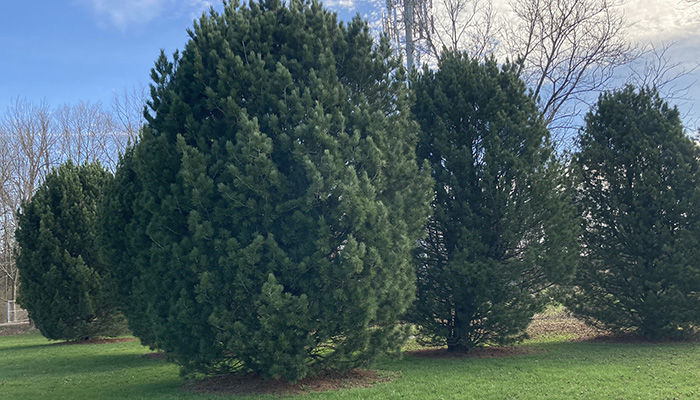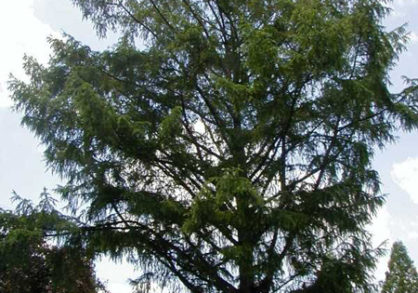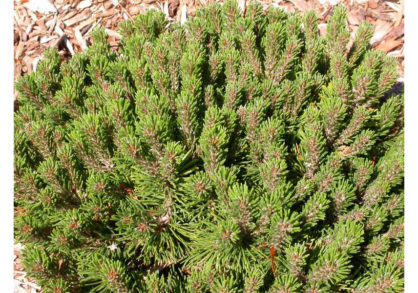I remember lying awake one night at the end of February 2022, images from the news running through my mind. The Russian convoy was halted 40 miles outside of Kyiv. Over 600,000 Ukrainian refugees had already fled the country. Now, a year later, that number is over eight million.
Gritty urban images of conflict in Kherson, Berdyans’k, and Mariupol saturated the news. But as I lay awake that night, I wondered about the natural beauty of this country that had suddenly, unfortunately become a global focal point: what trees grow in the forests of Ukraine? How can we connect to this distant land and people through plants? The next day, I searched Cornell Botanic Gardens for plants in our collections that are native to Ukraine.
The boreal forests of Ukraine are composed of many genera familiar to us in Upstate New York: conifers like pine, spruce, fir and larch; and deciduous hardwoods like beech, oak, linden, ash, maple, birch, poplar, willow, and elm.
At the base of Conifer Slope, near the Pounder Vegetable Garden, you can stand at the foot of a breathtaking 55-year-old silver fir (Abies alba shown below). Native to central and eastern Europe, its range sweeps across the western Carpathian montane forests of Ukraine, where it grows alongside beech and spruce. Silver fir is the tallest and most widespread of the nine species of fir (ялиця or yalytsia in Ukrainian) that grow in Ukraine, and the most important economically and ecologically. In the northeastern U.S., you might be familiar with the silver fir as a Christmas tree. In its native forests, it can grow as tall as 195 feet and as old as 600 years. In an impressive feat of inter-species opportunism, humans cultivate a rare and remarkable “fir honey” produced by bees who harvest the honeydew exuded by aphids feeding on the sap of silver fir.

Crossing Arboretum Road from the silver fir, you are greeted at the entrance to the Hillside Garden by the venerable cascade of a pendulous European hornbeam (Carpinus betulus ‘Vienna Weeping’ shown below). Just around the bend, in the heart of the Mullestein Winter Garden, you’ll discover a stately, fastigiate cultivar: Carpinus betulus ‘Columnaris Nana.’ Now leafless in winter, pale sunbeams illuminate its sinewy architecture, lustrous gray bark, and long, imbricate buds. In Ukraine, the European hornbeam (граб or hrab), is found predominantly in the Carpathian Mountains and the Crimea. These are slow-growing trees used for loom shuttles, parquet floors, musical instruments, tools, fuel, and as a resilient urban planting in parks and gardens. You can find its North American counterpart (Carpinus caroliniana) growing abundantly in our local forests.
Across the weathered millstone at the center of the Winter Garden, the constellation of delicate, snow-white catkins of a pussy willow will catch your eye on a late winter day (Salix caprea ‘Kilmarnock’). In Ukraine, branches of pussy willow (верба or verba) are incorporated in Palm Sunday observances instead of palm fronds. Willow wood is used for carving, cores for veneers, furniture, barrels, baskets and fences, and musical instruments such as the банду́ра or bandura: a Ukrainian instrument similar in construction and appearance to a lute.
Nine species of pine (сосна or sosna) cover over six million acres of Ukraine—34 percent of all forested land. Mountain pine (Pinus mugo) grows in subalpine regions and above timberline in the Carpathian forests, in peat bogs, and frost hollows. Their low shrubby growth with a bowed basal section of stem is an adaptation to deep snow cover and avalanches. The ability of their branch ends to be flattened by the weight of snow but easily spring erect again during the spring thaw make them a popular planting for erosion and avalanche control. Nine cultivars can be found throughout Cornell Botanic Gardens, such as the rich green, cheerfully globose Pinus mugo ‘Teeny’ in the Mullestein Winter Garden near the columnar hornbeam (shown below).

Swiss stone pine (Pinus cembra) grows throughout the mountains of southern Asia and central Europe, including a pocket of the Carpathian Mountains of Ukraine. Slow growing, long-lasting, and popular in cultivation as a landscape tree, it is also one of the few pines that produces edible pine nuts—although its cone morphology makes it more difficult to harvest than others. You can visit a grove of Pinus cembra at the highest elevation of the Arboretum along the Beech Loop (shown below).

At the center of the loop is a display of European beech cultivars (Fagus sylvatica; in Ukrainian, бук or buk), some over 50 years old. Ancient beech forests are preserved in the remote Carpathian Biosphere Reserve in Ukraine, protected as a UNESCO World Heritage site. Like our native North American beech (Fagus grandifolia), these iconic trees are threatened by a changing climate and increasing pressure from pests and pathogens.
As the days lengthen and we turn toward spring, search for the glow of cloth-of-gold crocus (Crocus angustifolius) in the Groundcover Collection. Native to the juniper woods, scrubland, and hillsides of the Black Sea region in the Crimea, cloth-of-gold flowers from February to March; perhaps a sign of hope for the emergence of both spring and future peace in Ukraine.
See them now on a walk through the main gardens or by clicking through the digital plant collection below.


